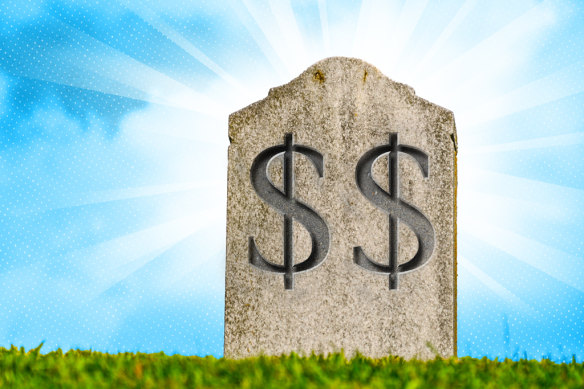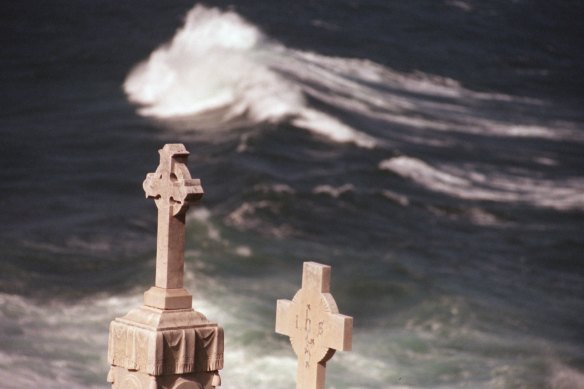Opinion
Forget the cost of living; what about the cost of dying?
Thomas Mitchell
Culture reporterUndoubtedly, one of the best things about travelling through regional Australia is that regional TV channels still air local ads from local businesses. There is something wholesome about watching a commercial for a family pizza shop (often filmed inside the pizza shop) and then walking down the road and seeing the people from the ad. Oh my god, look! It’s Big Joe from Big Joe’s Pizza; he doesn’t look anywhere near as big in real life!
The same charm doesn’t quite apply to funeral homes, however. During a recent trip to NSW’s Central West, I was sitting in my motel room thinking about livestock (I’d just watched an ad about livestock) when a voice on the TV reminded me it was never too early to plan ahead.

You want a nice plot in a prime location with water views? You better hope the afterlife has Afterpay. Credit: Michael Howard
The voice belonged to a man wearing an ill-fitting suit who appeared to be floating in the clouds. He explained that his family had been delivering compassionate care to the community for three generations when they needed it most. And when the time came, I should trust him with my final goodbye.
Watching along from the bathroom, my wife said he was the last person she’d trust, mostly because she couldn’t fathom being buried by a man in an ugly suit. I wanted to point out that she likely wouldn’t see the suit, being dead and all, but instead just remarked that I’d prefer to be cremated. “Absolutely not,” came the reply. “Cremation is off the table; you’re being buried next to me.”
When you’re sharing a life, you don’t tend to talk about death all that much, especially the logistics, but I always assumed I’d be cremated. Aside from a pathological fear of small spaces, being buried feels kind of old-fashioned, a real Boomer approach to death. Like even though I am gone, I must still maintain a tiny foothold in the property market. One bedroom, no bathroom, six feet underground.
Whereas cremation seems more dignified, Biblical even. You know, earth to earth, ashes to ashes, dust to dust? Thankfully, it turns out I had safety in numbers. According to the Australian Funeral Directors Association, more than three-quarters of Australians are cremated after their deaths.
Unfortunately, no amount of statistics could compel Kate to reconsider a topic she had obviously (and somewhat concerningly) spent a lot of time thinking about what to do with my remains. “I don’t care what most people do,” she explained. “We are being buried together somewhere nice.”
Admittedly, talking about finding a grave site, like we were discussing where to go on holiday, was very funny. Should we choose somewhere down the coast? Perhaps walking distance to the beach?
Less amusing was the idea that my dying wish might be ignored. The whole point of a dying wish is to leverage the seriousness of the situation. If it were something people could choose to ignore, it would be called a Dying Favour or Dying Request. Did you get my Dying Email? No, sorry, I’ve been flat out.
Concerned that I was losing control, I pivoted to the one argument I knew would move the needle: money. The average cremation cost in Australia can range from $3500 to $7000 per person. Usually, this price includes all required services and preparations linked to cremation. Meanwhile, even a basic burial will set you back around $8000, but can cost up to $15,000.

Tomb with a view?Credit: Michele Mossop
However, if you want a plot with a view, prepare to pay. Earlier this year, a double burial plot at Waverley Cemetery, the cemetery of choice for the richest corpses, was listed on Facebook marketplace for $100,000. And that’s got to be paid upfront; ain’t no Afterpay in the afterlife.
Welcome to Sydney, where you can’t afford to live or die in the city.
Through sheer force of will, it appeared I had worn Kate down when she relented and asked me exactly what I would like done with my remains. The obvious answer is to have them scattered somewhere special, but I worry that whatever location I choose while I am alive will be influenced by recency bias. If I died tomorrow, I’d probably demand my ashes be scattered across the Metro.
Instead, I’d prefer to be kept in an urn on the mantelpiece, maybe under a dramatic black-and-white photo of myself.
When the time comes (assuming I go first) and it’s Kate’s turn to be buried, then whoever is left can just sprinkle me into her coffin. Two eternal souls for the price of one spot? Talk about a dying wish.
Find more of the author’s work here. Email him at thomas.mitchell@smh.com.au or follow him on Instagram at @thomasalexandermitchell and on Twitter @_thmitchell.
Get a weekly wrap of views that will challenge, champion and inform your own. Sign up for our Opinion newsletter.